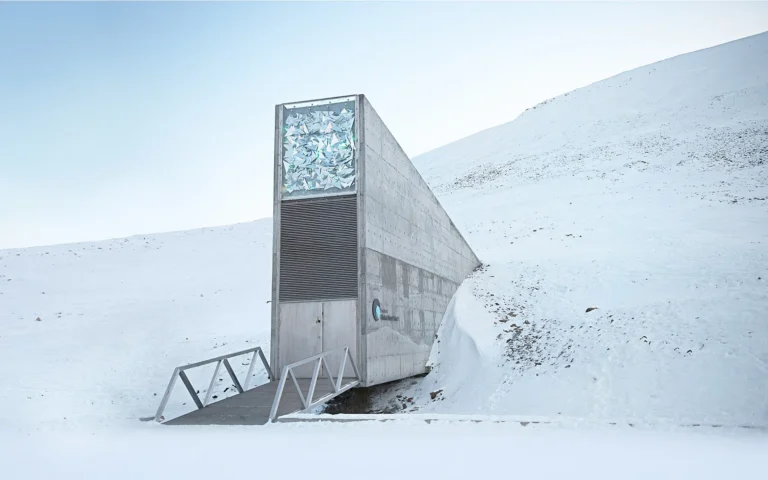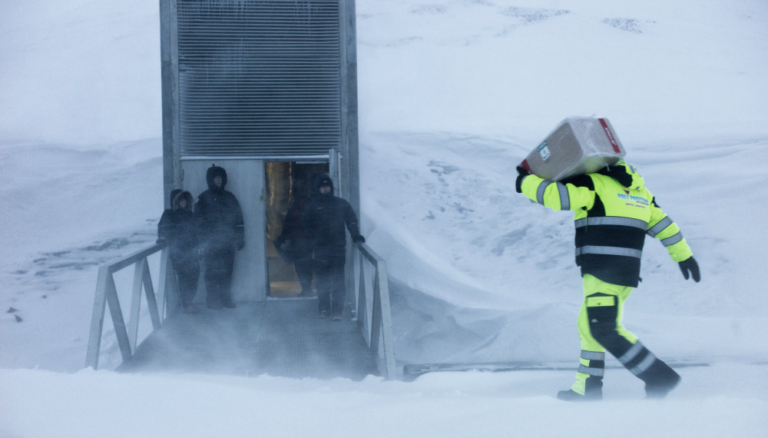
In the frigid Norwegian Arctic, nestled within Plateau Mountain on the island of Spitsbergen, a remarkable structure emerges—a gray wedge-shaped building known as the Svalbard Global Seed Vault. With its steel, mirrors, and prisms reflecting a ghostly green light, this enigmatic vault holds the key to preserving the world’s crop biodiversity. As we celebrate its 15th anniversary, we invite you on a virtual tour to uncover the secrets of this extraordinary sanctuary, aptly referred to as the “doomsday seed vault.”

The Guardian of Diversity
The Svalbard Global Seed Vault serves as the ultimate guardian of crop diversity. Over 1.2 million seed samples from nearly every corner of the globe are housed within its secure confines. Nations worldwide, including recent depositors Albania, Croatia, North Macedonia, and Benin, have entrusted their seeds to this repository. With the purpose of safeguarding crop biodiversity in the face of localized catastrophes, the vault stands as a symbol of hope, unity, and security in an increasingly unstable world.
Protecting Against Catastrophe
The Svalbard Global Seed Vault acts as a backup storage facility for a vast network of gene banks worldwide. Countries deposit copies of their seed collections in their respective gene banks, while the Svalbard facility serves as the ultimate safeguard. New additions are regularly made, including wild strawberries, wheat, maize, rice, and even seeds from the ajvarka red pepper variety, a beloved ingredient in traditional relishes. These diverse collections ensure the preservation of vital plant species and genetic resources.

A Beacon of Resilience
In times of crisis, the seeds held within the vault offer a glimmer of hope. Each depositing country retains ownership of their seeds, allowing them to withdraw their precious collections in the event of a local catastrophe. The true value of the vault became evident in 2015 when seeds were used to resurrect the International Center for Agricultural Research in the Dry Areas, providing a lifeline for agricultural progress in the aftermath of the Syrian civil war.
A Cathedral of Conservation
Stepping into the Svalbard Global Seed Vault, one is immediately struck by a sense of awe. Like entering a sacred cathedral, the vault’s towering shelves stretch from floor to ceiling, housing thousands of meticulously organized seed boxes. The serene atmosphere, marked by hushed silence, adds to the reverence of the space. With temperatures as low as minus 18 degrees Celsius, the international standard for seed preservation, the vault ensures the longevity and viability of its precious contents.

A Symbol of Global Cooperation
In a world often fraught with conflict and uncertainty, the Svalbard Global Seed Vault stands as a testament to the power of collaboration and global unity. Within its walls, nationalities and borders fade away, replaced by a shared commitment to preserving the Earth’s botanical heritage. As Brian Lainoff, the former lead partnerships coordinator of the Crop Trust, once remarked, “The seeds don’t care that there are North Korean seeds and South Korean seeds in the same aisle. They are cold and safe up there, and that’s all that really matters.”
Growing Toward the Future
Since its establishment in 2008, the Svalbard Global Seed Vault has steadily expanded its collection, solidifying its position as the world’s largest security reserve of seeds for food and feed crops. This remarkable achievement, backed by the Norwegian government, ensures the availability of essential genetic resources to address future challenges in agriculture and food security. The vault’s continued growth reaffirms its commitment to safeguarding the future of humanity’s vital food crops.
A Legacy of Preservation
As we reflect on the significance of the Svalbard Global Seed Vault, we are reminded of its profound legacy—a testament to our shared responsibility to protect the diversity of life on our planet. In a time of uncertainty and climate change, the vault stands as a beacon of resilience and conservation. Its presence serves as a reminder that through collective action and cooperation, we can nurture the seeds of a sustainable and food-secure future for generations to come.
